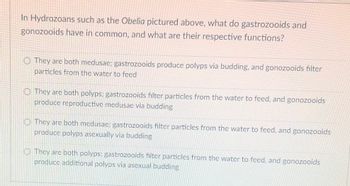
Human Anatomy & Physiology (11th Edition)
11th Edition
ISBN: 9780134580999
Author: Elaine N. Marieb, Katja N. Hoehn
Publisher: PEARSON
expand_more
expand_more
format_list_bulleted
Concept explainers
Question

Transcribed Image Text:In Hydrozoans such as the *Obelia* pictured above, what do gastrozooids and gonozooids have in common, and what are their respective functions?
- They are both medusae; gastrozooids produce polyps via budding, and gonozooids filter particles from the water to feed.
- They are both polyps; gastrozooids filter particles from the water to feed, and gonozooids produce reproductive medusae via budding.
- They are both medusae; gastrozooids filter particles from the water to feed, and gonozooids produce polyps asexually via budding.
- They are both polyps; gastrozooids filter particles from the water to feed, and gonozooids produce additional polyps via asexual budding.
Expert Solution
This question has been solved!
Explore an expertly crafted, step-by-step solution for a thorough understanding of key concepts.
This is a popular solution
Trending nowThis is a popular solution!
Step by stepSolved in 2 steps

Knowledge Booster
Learn more about
Need a deep-dive on the concept behind this application? Look no further. Learn more about this topic, biology and related others by exploring similar questions and additional content below.Similar questions
- A previously unknown animal is being studied so that it can be classified. It is an invertebrate, triploblastic, dorsoventrally flattened, acoelomate, and has flame cells. Which phylum would you place it in? A)Arthropoda. B)Porifera C)Mollusca. D)Platyhelminthes. E)Cnidaria.arrow_forwardFill in the blank to escribe the route of water through an synconoid sponge by listing the numbers in the correct order. To answer - write the numbers with a space in between - e.g. 1 2 3 4 5 6 7 1. osculum 2. spongocoel 3. ostium in porocyte 4. apopyle 5. radial canal 6. prosopyle 7. incurrent canalarrow_forwardCompare and contrast the Phyla Porifera and Cnidaria. Think: Symmetry, Form and function, Tissue layers (present or absent, if present which are represented), Musculature/how they move, Reproduction, Nervous system and sensory structures, Respiration, Digestion (and how they feed), and comment on unique cell types found in each.arrow_forward
- Which of the following statements regarding the anthozoans is false? They have symbiotic algae living in their tissues They are restricted to comparatively shallow waters They are the reef building corals They spend most of their life in the medusa body formarrow_forwardYou find a bivalve mollusc with very short siphons. You can thus predict that inhabits a shallow burrow. inhabits a deep burrow. is a deposit feeder. is a carnivore. it is a surface dweller. You find a polychaete in the lower Chesapeake Bay and discover that its coelom is unpartitioned. You can then predict that it will possess: a metanephridial system a protonephridial system secretion kidneys end sacs Octopi are known for their ability to learn. True Falsearrow_forwardImagine you come across an animal with a worm-like biody. Determine whether it is a polychaete or a member of class Hirudinida? Give two distinct differences between the two without naming the same structure/invisible features of each animal (e.g animal x has 2 wings, animal y has 4 wings are not distinct differences)arrow_forward
arrow_back_ios
arrow_forward_ios
Recommended textbooks for you
 Human Anatomy & Physiology (11th Edition)BiologyISBN:9780134580999Author:Elaine N. Marieb, Katja N. HoehnPublisher:PEARSON
Human Anatomy & Physiology (11th Edition)BiologyISBN:9780134580999Author:Elaine N. Marieb, Katja N. HoehnPublisher:PEARSON Biology 2eBiologyISBN:9781947172517Author:Matthew Douglas, Jung Choi, Mary Ann ClarkPublisher:OpenStax
Biology 2eBiologyISBN:9781947172517Author:Matthew Douglas, Jung Choi, Mary Ann ClarkPublisher:OpenStax Anatomy & PhysiologyBiologyISBN:9781259398629Author:McKinley, Michael P., O'loughlin, Valerie Dean, Bidle, Theresa StouterPublisher:Mcgraw Hill Education,
Anatomy & PhysiologyBiologyISBN:9781259398629Author:McKinley, Michael P., O'loughlin, Valerie Dean, Bidle, Theresa StouterPublisher:Mcgraw Hill Education, Molecular Biology of the Cell (Sixth Edition)BiologyISBN:9780815344322Author:Bruce Alberts, Alexander D. Johnson, Julian Lewis, David Morgan, Martin Raff, Keith Roberts, Peter WalterPublisher:W. W. Norton & Company
Molecular Biology of the Cell (Sixth Edition)BiologyISBN:9780815344322Author:Bruce Alberts, Alexander D. Johnson, Julian Lewis, David Morgan, Martin Raff, Keith Roberts, Peter WalterPublisher:W. W. Norton & Company Laboratory Manual For Human Anatomy & PhysiologyBiologyISBN:9781260159363Author:Martin, Terry R., Prentice-craver, CynthiaPublisher:McGraw-Hill Publishing Co.
Laboratory Manual For Human Anatomy & PhysiologyBiologyISBN:9781260159363Author:Martin, Terry R., Prentice-craver, CynthiaPublisher:McGraw-Hill Publishing Co. Inquiry Into Life (16th Edition)BiologyISBN:9781260231700Author:Sylvia S. Mader, Michael WindelspechtPublisher:McGraw Hill Education
Inquiry Into Life (16th Edition)BiologyISBN:9781260231700Author:Sylvia S. Mader, Michael WindelspechtPublisher:McGraw Hill Education

Human Anatomy & Physiology (11th Edition)
Biology
ISBN:9780134580999
Author:Elaine N. Marieb, Katja N. Hoehn
Publisher:PEARSON

Biology 2e
Biology
ISBN:9781947172517
Author:Matthew Douglas, Jung Choi, Mary Ann Clark
Publisher:OpenStax

Anatomy & Physiology
Biology
ISBN:9781259398629
Author:McKinley, Michael P., O'loughlin, Valerie Dean, Bidle, Theresa Stouter
Publisher:Mcgraw Hill Education,

Molecular Biology of the Cell (Sixth Edition)
Biology
ISBN:9780815344322
Author:Bruce Alberts, Alexander D. Johnson, Julian Lewis, David Morgan, Martin Raff, Keith Roberts, Peter Walter
Publisher:W. W. Norton & Company

Laboratory Manual For Human Anatomy & Physiology
Biology
ISBN:9781260159363
Author:Martin, Terry R., Prentice-craver, Cynthia
Publisher:McGraw-Hill Publishing Co.

Inquiry Into Life (16th Edition)
Biology
ISBN:9781260231700
Author:Sylvia S. Mader, Michael Windelspecht
Publisher:McGraw Hill Education